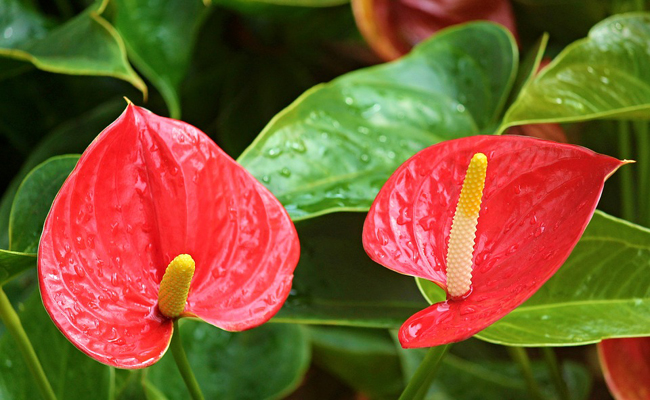Anthurium (Anthurium sp.) or tongue of fire, with its red inflorescence, is a plant native to tropical America that is very frequently found in our interiors, due to its ease of cultivation.

Its dark green, shiny, leathery, persistent, heart-shaped or spearhead leaves, with pointed ends, easily measure up to 25cm: they stand at the top of a long petiole which can reach 30cm.
Its brightly colored flowers, 8 to 12cm long, comprise a thin, curved yellow spadix surrounded by an oval, scarlet-red spathe.
Very similar to the spathiphyllum or moonflower, the anthurium is distinguished by the color of its inflorescences: white for the first and red, most often, for the second. The difficulty of the anthurium is to make it bloom again…
As the plant is toxic, handling must be done with caution, especially at the level of the sap and the leaves. Anthurium is indeed often very irritating to the touch and can cause problems if ingested. Anthurium pollen can cause allergies and migraines in sensitive people.
Anthurium would have a significant depollution capacity, particularly for the elimination of ammonia. The plant also absorbs xylene and, to a lesser extent, formaldehyde.
- Family : Araceae
-
Kind : indoor plant -
Origin : South America -
Flower color: red, pink, salmon, red speckled cream -
Sowing: Yes -
Cutting: No -
Planting: spring -
Bloom : all year - Height : up to 60cm
Ideal soil and exposure for growing Anthurium in pots
Anthurium thrives comfortably in light soil, such as an orchid substrate or a mix of potting soil, sand and coconut fiber. The plant requires a large source of light, especially in winter, without direct sunlight, sheltered from drafts.
Date of sowing and repotting Anthurium
Propagation is generally done in the spring during repotting, by division of clumps, each of which will be planted in a pot at 21°C. Sowing is generally a matter for experts.
Repotting is to be done every two years towards the end of winter, at the beginning of spring: place clay balls in the bottom of the pot to promote drainage and prevent the roots from being soaked with water.
Council of maintenance and culture of the Anthurium
Watering with rainwater or non-calcareous water must be frequent in summer and reduced in winter without letting the pot soak in water. Regularly moisten the foliage by misting.
Leaf pruning can be done on bushy plants to allow new flowers to develop well. Cut off any faded flowers.
Diseases, pests and parasites of Anthurium
Excess water causes root rot. Spider mites and mealybugs can invade the Anthurium.
Location and favorable association of Anthurium
Placed indoors, the anthurium will appreciate a room facing west, whether it is a living room, a dining room or a bathroom.
Recommended species and varieties of Anthurium to decorate its interior
Genre Anthurium has nearly 900 species comprising evergreen perennials that are often epiphytes. However, at the florist, you will generally be offered Anthurium scherzerianum, very floriferous and quite compact, with inclined, almost vertical leaves, flowers 8 to 10cm long, whose bright red spathes fall with their orange-red spiral spadix. Different cultivars are offered such as ‘Wardii’ with red stems, dark red spathe and red spadix, ‘Rothschildianum’ with red spathes, spotted with white and yellow spadix…
Anthurium andreanumhas spathes 10 to 12cm long, erect, wrinkled to waffle, red with a yellow spadix, but depending on the cultivar, the spathes can be pink, salmon, red, red dotted with yellow, cream dotted with red or pink. ..
